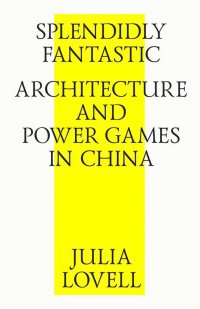Splendidly Fantastic: Architecture and Power Games in China = Необычайно восхитительно: архитектура и власть в Китае
Покупка
Тематика:
Теория и история архитектуры
Издательство:
Стрелка Пресс
Автор:
Ловелл Джулия
Год издания: 2017
Кол-во страниц: 45
Дополнительно
Вид издания:
Научно-популярная литература
Уровень образования:
Профессиональное образование
ISBN: 978-5-9903364-5-2
Артикул: 688063.01.99
Mao once called the Chinese «a blank sheet of paper», and the modernising
that came with the Cultural Revolution treated cities much the same. But Mao’s
destructive impulses were as nothing compared to the liberalised policies of his
recent successors. China has undergone urbanisation on a scale never seen
before — much of it speculative, some of it a brazen display of power. In this
incisive analysis by the acclaimed Sinologist Julia Lovell, we get inside the politics
of architecture and city-making in China. There is a colourful cast, from the
Western starchitects rushing into the land of opportunity, to political dissidents
such as Ai Weiwei, to rebellious residents singing defiantly as the bulldozers
advance. In this trenchant critique of urban policy, Lovell wonders what good all
this thrusting ambition will have been if the property bubble bursts.
Тематика:
ББК:
УДК:
ОКСО:
- 07.00.00: АРХИТЕКТУРА
- ВО - Бакалавриат
- 07.03.01: Архитектура
- 07.03.03: Дизайн архитектурной среды
- 07.03.04: Градостроительство
- ВО - Магистратура
- 07.04.01: Архитектура
- 07.04.03: Дизайн архитектурной среды
- 07.04.04: Градостроительство
ГРНТИ:
Скопировать запись
Фрагмент текстового слоя документа размещен для индексирующих роботов
ДЖУЛИЯ ЛОВЕЛЛ НЕОБЫЧАЙНО ВОСХИТИТЕЛЬНО: АРХИТЕКТУРА И ВЛАСТЬ В КИТАЕ 3-е издание (электронное) Москва «Стрелка Пресс» 2017
JULIA LOVELL SPLENDIDLY FANTASTIC: ARCHITECTURE AND POWER GAMES IN CHINA 3-rd edition (electronic) Moscow Strelka Press 2017
УДК 72
ББК 85
L94
Lovell, Julia.
L94 Splendidly Fantastic: Architecture and Power Games in China = Необычайно восхитительно: архитектура и власть в Китае [Электронный ресурс] / J. Lovell. — 3-rd ed. (el.). — Electronic text data (1 file pdf : 45 p.). — М. : Strelka Press, 2017. — System requirements: Adobe Reader XI or Adobe Digital Editions 4.5 ; screen 10".
ISBN 978-5-9903364-5-2
Mao once called the Chinese «a blank sheet of paper», and the modernising that came with the Cultural Revolution treated cities much the same. But Mao’s destructive impulses were as nothing compared to the liberalised policies of his recent successors. China has undergone urbanisation on a scale never seen before — much of it speculative, some of it a brazen display of power. In this incisive analysis by the acclaimed Sinologist Julia Lovell, we get inside the politics of architecture and city-making in China. There is a colourful cast, from the Western starchitects rushing into the land of opportunity, to political dissidents such as Ai Weiwei, to rebellious residents singing defiantly as the bulldozers advance. In this trenchant critique of urban policy, Lovell wonders what good all this thrusting ambition will have been if the property bubble bursts.
УДК 72
ББК 85
The source print publication: Splendidly Fantastic: Architecture and Power Games in China / J. Lovell. — Moscow : Strelka Press, 2014. — 43 p. — ISBN 978-0-9929-1466-0.
ISBN 978-5-9903364-5-2
© Strelka Institute for Media, Architecture and Design, 2014
As autumn turned to winter in 2007, Beijing was transfixed by its newest landmark: the leaning twin towers of China Central Television’s half-finished headquarters. Masterminded by Rem Koolhaas for the Office for Metropolitan Architecture (OMA), the building was a startling departure from the straight-up-and-down skyscrapers that dominated the rest of the capital’s Central Business District. Koolhaas’s massive structure was to be an angular loop: a pair of asymmetrical legs (234 and 194 metres tall) linked by a crowning L-shaped tube. That November, the city was buzzing with rumours that any day now the towers — two black, diamond-patterned chopsticks tilting unsteadily towards. each other through the smog — would be joined. Enhancing the mysticism of the event, the project’s engineers (the high-priests of this architectural cult) had decreed that the connection had to be made at dawn, to ensure the equal temperature of both sides. Obsessed bloggers and amateur photographers stalked the building in both the virtual and real worlds; journalists eked out their nights at the Foreign Correspondents’ Club bar, listening for tip-offs that the dawn to come would be the dawn.
When spectators weren’t generating pseudo-facts about the building — about how it was supposedly the largest building in the world (besting the Pentagon), dependent on untested engineering wizardry, resting on a site the size of thirty-seven football fields — they were debating its controversial politics. By designing the headquarters of China’s most censored media outlet, was Rem Koolhaas — architecture’s philosopher-king — giving a glaze of avant-garde sophistication to an organisation that was Maoist in its commitment to controlling information? Was it appropriate to let a building that some have described as a monumental “twisted pretzel”, a “deformed doughnut”, or even as a sci-fi monster overshadow an historically low-rise imperial capital that was already being smashed
— 5 —


